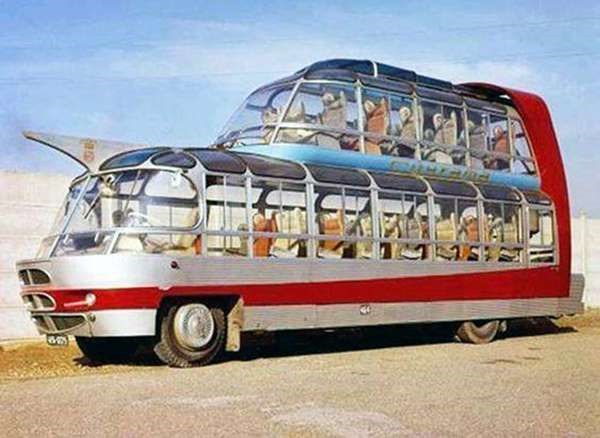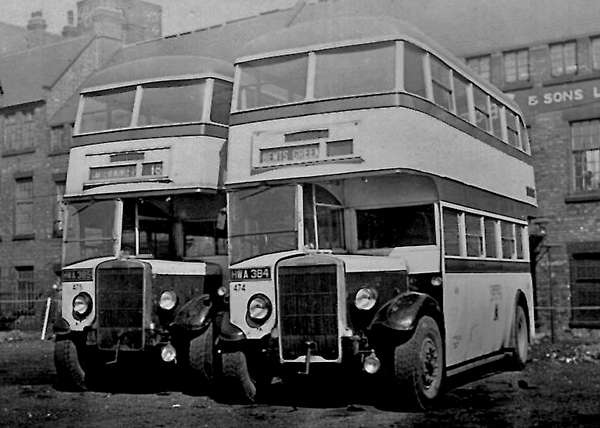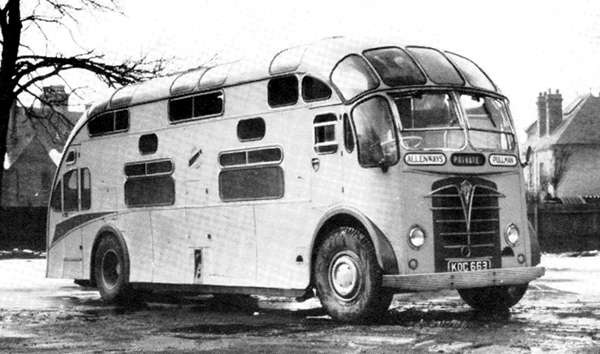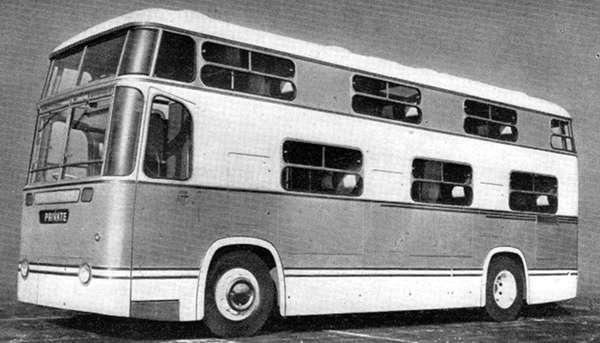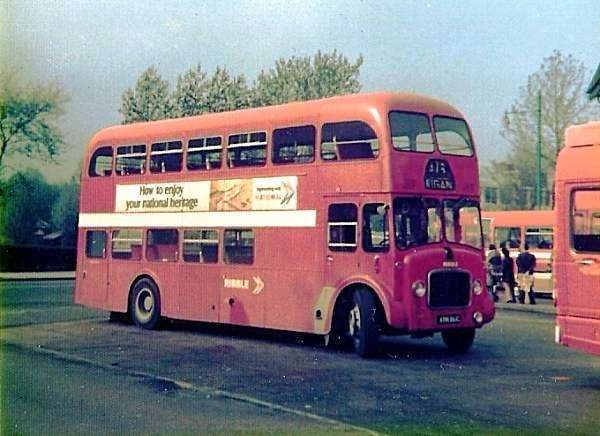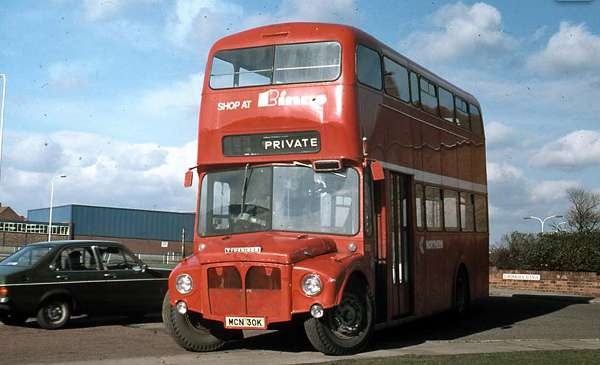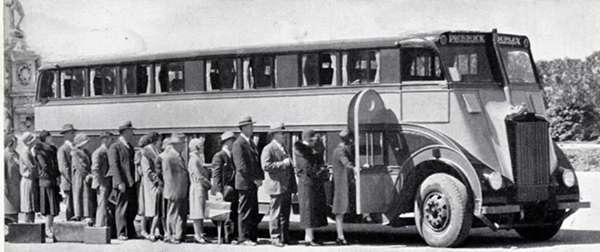The Ugly Bus Page
This page is exactly for what the heading states, it does not matter if you do not have a picture of your particular ‘Ugly Bus’ somebody may be kind enough to contribute one for us all to view.
31/01/17
A Red and Silver Ugly Bus
Again, no idea of copyright – what is this then?
Over to the experts
Roger Ingle
If you would like to comment on the above please click here
31/01/17 – 11:03
I think Lady Penelope would find this a a bit naff. Is that Russian on the side? They always seemed to like the Dan Dare look…
Joe
31/01/17 – 11:04
Roger, this was, I believe, a weird Citroen U55 Cirrus, built for Paris Cityrama tours. I photo’d it (or one of them if there were more than one) in 1961, and it certainly turned heads. Citroen were, at this time, famous for design flair, but maybe this was a flair too far? www.flickr.com/photos/tramfan/
Paul Haywood
01/02/17 – 07:39
My first thought was a Frank Hampson creation for a Dan Dare strip?
Roger ingle
19/01/19 – 07:13
IXO made a 1:43 scale model of this for Hachette, it is readily available.
One of the full-size ones is in preservationist hands.
Stephen Allcroft
19/01/19 – 16:33
There is more information here:- www.messynessychic.com/2012/07/22/ including a photo of three together, and some information about the survivor. There is also a photo of a slightly different version, with the upper deck extending further forward.
Nigel Frampton
20/01/19 – 07:02
There is also a short film (not to be taken too seriously!):- https://vimeo.com/134337291
A search on Google for "citroen u55 cityrama" delivers several results – some are, naturally, in French!
Nigel Frampton
21/01/19 – 07:14
One of these appeared in at least 14 films or TV series. www.imcdb.org/vehicles.php
John Lomas
21/01/19 – 07:15
Saw both versions on a school trip to Paris in 1962. Whilst they drew my attention, they were just another Parisian oddity along with the the various ancient looking RATP buses, the single rear wheel Berliet and Saviem coaches and the rubber tyred Metro trains to a 15 year old raised on the British transport scene.
Phil Blinkhorn
06/07/22 – 06:38
I recently came across a recent YouTube video in which someone had tracked down one of these in la France profonde. It came out of a barn for a day, which showed that it was in quite a state, but restorable, with adequate time and money, which is the intention.
Chris Hebbron
I’ve just discovered that one of these survives and is under restoration by Normandy Classics. This YouTube link explains more.
https://www.youtube.com/watch?v=dqy2pk3R2WE
Paul Haywood
06/04/16
Quite Something Nonetheless
No idea about copyright or indeed the bus but quite something nonetheless…..
Roger Ingle
If you would like to comment on the above please click here
07/04/16 – 05:53
This link doesn’t add much but may be of interest. It’s incredible how many of these "one-offs" were built in the 1920s/30s (mainly in the USA). Being 11 feet wide and higher than most vehicles on the road at that time, its route must have been very limited (probably on early Italian autostradas). https://books.google.co.uk/books
Paul Haywood
07/04/16 – 08:02
My word Paul, you’ve certainly done us all a great service by identifying this terrifying but impressive beast. Always one to delight in trying a new and revolutionary model when I was a driver I’m sure that I’d have run a mile rather than tackle that !! Amongst other things, unless its an illusion, it appears to have single rear wheels on the rearmost axle – the thought of a tyre blow out on the autostrada makes one cringe, and would make any attendant tyre fitter (if one could be found) consider his options.
Chris Youhill
07/04/16 – 10:26
Further research reveals this to be a Lancia Omicron L dating from 1932.
Seemingly there were two (B3401 and B3403) and had petrol engines. In 1936/7 they were re-engined with Junkers 90 diesels (become D3401/3403).
As can be assumed from the photos, they had a Duplex seating layout, apparently accommodating 92 passengers (which must have been very claustrophobic). The "third" deck was reserved for 1st class passengers, with more spacious seating.
Their design was heavily influenced by similar buses operating in Detroit and were used on interurban tourist routes from Rome to Tivoli (along the long and straight Via Tiburtini) and to Ostia.
Most of the photos I have found so far are on Pinterest which is a pain to access unless you have "joined". If you are members, search for "Lancia Omicron L B3403".
Difficult to be sure, but to answer Chris Y’s query, the rear tyres seem very wide. One illustration shows the front tyres with the Michelin marks highlighted (probably for publicity purposes) but whether the rear ones were double or very wide singles is difficult to tell. www.picautos.com/
Paul Haywood
07/04/16 – 13:38
This is certainly different. It seems that the ‘Harry Potter’ triple deck RM is not all that far adrift. Surely JK Rowling or a member of her film team didn’t design this?
Pete Davies
07/04/16 – 13:39
Looking at the proportions in the picture, I suspect that the 11 feet reference, taken presumably from the Pop.Mechanics page, is actually a height reference rather than width.
The height does look to be 1 third of the length, I can’t imagine a bus 11 feet wide and 11 feet high
John Lomas
07/04/16 – 14:30
They must have remained in service for a little while as the collection of pictures linked above shows evidence of a repaint (unless the two sisters were painted in differing liveries, which I think is unlikely).
Petras409
07/04/16 – 14:32
Quite right, John, the eleven foot width was a quote from the US magazine, but this photo gives an idea of its imposing appearance. You wouldn’t argue with it in a tight squeeze.
Further trawling reveals that there was serious thought given to a full length Triplex version with the option of an open top on the third deck. The mind boggles.
In view of Italy’s (Mussolini’s) quest to gain dominance for air, sea and land transport at this time, this bus must have seemed to be cutting edge technology. Not sure I would relish a ride unless sitting near to the emergency exit. https://it.wikipedia.org/wiki/
Paul Haywood
08/04/16 – 06:16
Wonderful collection of pics in that Wikipedia file, Paul, although the text page only appears for seconds. The Lancia is nearly beaten by the Pickwick Lines decker, steered from upstairs with the exhaust- seemingly- up the middle of the windscreen. What is it? The Lancia doesn’t look as bad in some shots, and you can see the risks reduced as it creeps past a horse and cart: 25 mph must have been an ambition. There are also some layout plans- obviously this is where your Crellin came from.
Joe
08/04/16 – 15:38
Joe
If you click on the X, top RH corner when the pictures show, then you will return to the text page without interruption; you will however then need a translator unless you can read what I think is Italian.
John Lomas
08/04/16 – 16:53
Thanks for the tip, John re Wikipedia. If you then click the menu there is a Google translate, and you can read it in a sort of Hoffnung English (remember?). It tells us quite a lot- the idea came, I think when overseas tram management was stopped/restricted and the replacement buses were much smaller- too small. There is also a note about Pickwick who ran Crellin type buses to places in the US where there was no railroad. The best bit is at the bottom- a link to a Youtube film of the Lancia en route, including the claustrophobic interiors. In true Italian fashion, the driver hoots at anything else that moves or may move so this is a constant feature. Lovely transmission noises, but at the end as it slows, a hunting noise like a giant preselector. Any ideas? Enjoy!
Joe
09/04/16 – 05:42
Thanks, Joe, for unearthing this fascinating film. I was interested to see the remains of the roadside steam tramway which closed in 1931 and (partly) replaced by this bus. The interior access for the 1st class passengers on the third level seemed a bit complicated and I would have hated to have to make an emergency evacuation.
Thanks to Roger for bringing this incredible vehicle to our attention. A remarkable bus with a wealth of information just waiting to be unearthed.
Paul Haywood
14/04/16 – 05:59
Thanks, Roger Ingle, for this extraordinary posting, and to Paul Haywood and Joe’s very informative links.
The interior shots in the film show just how ingenious the layout was, and–as has already been pointed out—what a nightmare any attempt to escape would be in case of fire or overturning. At one point in the film it looked as though the retractable steps for access to the upper seats blocked the door on the lower level. That narrow-looking track gives no impression of stability and I wonder whether the body was actually 8’6" wide–the American maximum in many states for many years–built on a chassis designed to carry a 2.2m (7’3") body? All speculation, this, because I don’t know what the size regulations were in prewar Italy. Whatever the truth, the body looks more overwide than British postwar 8′ rebuilds on old 7’6" chassis.
I tried to read the metric dimensions on one of the drawings, but couldn’t. Did anyone have more luck?
Was some of the sound dubbed? Towards the end, where the bus winds its way up a hill, you might expect a consistent engine note and gear whine; the rising-falling woo-woo-woo sounds suspicious to me.
As for "ugly bus"–certainly not! Eccentric and top-heavy, yes, but I think it’s a real good-looker.
Ian Thompson
14/04/16 – 10:26
The strange transmission noises at the end of the film sound like a hunting gearbox as the bus slows for the twisty rather than hilly bits?
Joe
15/04/16 – 07:21
It is tempting to think that we are listening to the actually sounds of this bus but the technology to sync film and sound was very basic (if not impossible) in those days and the film was probably heavily edited in the studio after filming. Genuine bus sounds, no doubt, but probably nothing like the real sequence of events.
Paul Haywood
15/04/16 – 07:22
I agree with others, not an ugly bus at all. Perhaps there should be an ‘Extraordinary Bus’ page.
Roger Ingle
15/04/16 – 07:23
I will move this thread to ‘Best Bits’ later today if that’s OK.
Peter
10/12/14
‘Ugly Sisters’
Sheffield was allocated a pair of Unfrozen All-Leyland Titan TD7’s in 1942, which were intended originally for Western SMT. They were therefore fitted with Scottish-type destination indicators which sadly turned these fine looking vehicles into ugly ducklings. Here’s a view of the ‘Ugly Sisters’ glowering at us whilst at rest.
Picture courtesy of The Tom Robinson Collection
John Darwent
If you would like to comment on the above please click here
10/12/14 – 08:32
A bit harsh to put these two in the ‘ugly’ section, they look just fine to me.
Berisford Jones
10/12/14 – 08:33
Point taken John, but I think that this "administrative WW2" blemish doesn’t detract substantially from the beauty of the classic Leyland body shape. However I’m sure that some relatively inexpensive repanelling etc to standard layout should have been undertaken as soon as possible by Sheffield, normally a top class and proud operator.
Chris Youhill
10/12/14 – 10:08
If beauty be in the eye of the beholder, then the opposite must also be true! Each to his own . . . Hundreds of all-Leyland Titans were built in the late 1930s, this body being developed postwar and continuing to be extremely popular, all versions being easy on the eye. Operator’s individualistic destination box arrangements didn’t always help buses to look their best, but there were a lot worse than that seen here.
Anon
10/12/14 – 10:09
The remarkable thing is that, in the midst of the maelstrom of militarism of 1942, there is virtually nothing, superficially, to suggest that these fine vehicles were not a pre-war product. I seem to recall that, in the original ‘Cinderella’ fairy tale, the sisters were considered to be ‘proud & haughty’, an apt description for these two in the twilight of their lives. And being more down-to-earth, can someone say when they were finally withdrawn?
Chris Hebbron
10/12/14 – 12:03
I know the story of wartime construction is complicated. But am I not right in saying that, generally speaking, "unfrozen" referred to the release of work in progress stopped by the Ministry of War Transport’s embargo? So, depending where on the production line a particular vehicle might be, unfreezing could quickly produce virtually standard pre-war spec. buses. If construction of these bodies had progressed to the degree of having standard Western SMT destination displays, the inference is that they were nearly complete already when "frozen".
Stephen Ford
10/12/14 – 15:20
I was surprised – shocked, even – to see a pair of Leyland bodied Leyland Titans appearing in the Ugly Bus section. I know that the TD7 variety was not particularly popular with some operators, but I understand that this was due to transmission matters, not appearance or structural defects. Apparently the type worked well on long journeys, but the slow gear change was unsuitable for short local services with frequent stops/starts. I can understand that some would think that the protruding destination display was rather ugly, but it doesn’t seem that bad – just rather difficult to read at a distance on a dark night perhaps. But, as is often said on this site, and rightly so, everyone is entitled to their own view of a beauty or an ugly bus. It’s worth it for the entertainment value of all the comments!
Michael Hampton
10/12/14 – 17:42
Just cannot comprehend how anyone can call Colin Bailey’s masterpiece ugly. Even the most beautiful teenager can have the odd acne spot.
Phil Blinkhorn
11/12/14 – 06:37
Leaving aside these two vehicles, I’ve always had a dislike of those destination displays even when fitted to the Scottish fleets. The "added on" appearance of the assembly simply doesn’t "gel" with any curved front, and the incongruous curved top to the upper aperture in an otherwise rectangular fitting is just the straw.
I understand from older drivers of the three Samuel Ledgard TD7s that the slow gear change resulted from a very heavy flywheel, fitted by Leyland for a reason which I can’t recall having heard about. A friend of mine who joined the Company only a very short time before me took his test on one of the three (JNW 288/9/90) and managed very well but he was already an experienced HGV driver.
Chris Youhill
11/12/14 – 06:37
This batch of unfrozen TD7s seem to have been fairly well distributed, Midland General received one, complete with the same Scottish style destination box, it was registered HRA 417 and MGO later rebuilt the front panel to their standard layout. It served them well for seventeen years.
This final development of the pre-war Leyland double deck body appears to be virtually indistinguishable from the standard post-war PD1 body, apart from the drivers windscreen and cab door.
Chris Barker
12/12/14 – 06:27
London Transport were given seven unfrozen TD7’s, although with utility bodies. They were classed as STD’s, but nothing like the pre-war TD4’s of the class. LT promptly allocated them to Victoria Garage, where they worked into and out of London’s busiest streets, a task to which they were totally unsuited, with heavy flywheel and inevitably painfully slow gear-changes and running late, which did not endear them to passengers, either.
They lasted in revenue service until 1951, when staff refused to drive them any more. They were then used as staff buses to/from Aldenham, a more suitable task, with longer runs. They were finally used as learner vehicles, a cruel fate for new drivers! Amazingly, they outlasted all the other utility buses in the fleet, perhaps because nobody wanted to buy them, resulting in them all going to an early grave in late 1955, unloved, even down to the faded paintwork they carried. They were LT’s longest-lasting utilities, giving 14 year’s service, still with original bodies.
Chris Hebbron
13/12/14 – 06:32
These 2 are parked up on the "cleared" ground in Pond St. I think they look dirty more than ugly.
Andy Fisher
22/02/16 – 06:19
The heavy flywheel on the TD7 was fitted to reduce the rock arising from the flexible engine mountings. Previous models up to the TD5 (the TD6 was the Birmingham version that, with modifications, became the TD7 for general sale) had a virtually solid mounting. Ironically, the flexible system gave some trouble, and most TD7s reverted to the earlier solid mounting system, but the ponderous flywheel remained.
Roger Cox
12/05/14
Chicago Motor Coach Co
Thought that this bus might well qualify in the ugly bus stakes. I know nothing about it other than the Chicago Motor Coach Co. logo.
Chris Hebbron
13/05/14 – 08:54
Well, Chris, at least it shows individuality! Could it have been built in open-staircase form and later had that bizarre enclosure added? And is it on solids at the back and pneumatics at the front, as some British steam waggons were?
Ian T
13/05/14 – 13:06
I’d say utilitarianaly functional rather than ugly. Given the winter snows in Chicago, the staircase covering is probably part of the original spec.
Phil Blinkhorn
20/01/14
One-and-a-Half-Decker
Yet another drawing board ‘doodle’ (what else) that became reality, but how? Looking at the other (similar) vehicles on this page I am wondering if it could be yet another "Crellin-Duplex" with the addition of a DA rear end? This registration is from October 1949 – Birmingham – and perhaps you learned gents who contribute such detailed and interesting history of our favourite topic may well be able to ‘shine further light’. I would dearly love to see a rear shot of this horror ! In the late 50’s I did a few part-time trips for Allenways but have no recollection of this beast.
Nigel Edwards
21/01/14 – 06:43
This coach was one of two such vehicles supplied to Allenways in 1950. They had 43 seat Crellin Duplex style bodies by the Lincs Trailer Company mounted on 27 ft long Foden PVSC chassis powered by the Foden FD6 4.1 litre two stroke engine. A contemporary advertisement may be seen here:- www.flickr.com/
I wonder how long these coaches remained in service with their original owner.
Roger Cox
Phil Blinkhorn
I wonder if the Lincs Trailer Company built horse boxes as this looks very much like it has been modified at the drawing stage from a horse box.
A bit of digging has found this: //archive.commercialmotor.com
Note the manufacturer is stated as "Lines" not "Lincs" twice so may not be a typo.
Phil Blinkhorn
21/01/14 – 12:05
A fin on the rear would just about finish off any credibility!
Although the transcription states ‘Lines’, the article itself states ‘Lincs’.
Chris Hebbron
21/01/14 – 12:06
The CM Archive contains some wonderful stuff, but their text is at the mercy of the Optical Character Recognition routines they employ and it’s always worth checking back. Things like old fashioned fractions of pence and miles are particularly badly handled. If you look at the image itself on the rhs of the screen, Phil, you’ll find that it is indeed Lincs, in the shape of the Lincs Trailer Co., Ltd., of Scunthorpe as Roger stated!
Tony Fox
21/01/14 – 15:04
NOT an ugly bus—to my eyes at least. This Mann-Egerton bodied one-and-a-half-decker of 1952 shows how the unusual internal layout need not necessarily lead to outward design horrors. The lack of front radiator suggests a rear-engined Foden chassis.
Ian Thompson
24/01/14 – 16:56
Roger Cox (21/01/14) wonders how long those half deckers remained in service with their original owner. According to the PSVC Allenways fleet list, they were new in 6/50. KOC 662 was withdrawn in 12/53 and passed to Marsden, Aldershot. KOC 663 was withdrawn in 7/58 and passed to Kellogg, Manchester as a van, though unfortunately no date is given for this conversion. The chassis type was actually PVFE6, the PVSC being the Gardner engined type.
The photo with Ian Thompson’s post was of a 50 seat Foden PVRF6 subsequently registered LYE 100 and first operated by Popular, London E16.
David Williamson
27/01/14 – 17:23
I know I’ll be regarded as a heretic by many fellow enthusiasts, but my candidate for the title of second most ugly bus is the Southdown Queen Mary. Despite progressing into rounded windscreens the QM remained an unqualified aesthetic disaster. Even the exceedingly attractive Southdown livery did little to alleviate its ugliness. And the title of ugliest bus? That goes to the Ribble look-alike.
Peter Phillips
28/01/14 – 12:06
Peter Phillips could be risking life and limb with his comments on Southdown Queen Marys. I wouldn’t call them second ugliest, but they do have weak points aesthetically. One is the short window bay amidships. I have always been curious about this, as NCME built 30′ length double-deckers for others (e.g. Lancs United on Guy Arab IV and V) with equal length window bays throughout. (If all were not completely equal, there was no short RML-like addition in their case). To me the real hotchpotch was the final batch of 30, delivered in 1967 (Nos 346-369), known as "The Panoramics". The modern (for the time) long side windows and wrap round upper deck windows clashed with the traditional curved front windscreen, and the final rear windows retained the traditional curve. It was a strange mix of futuristic and anachronistic. Add to that, complaints about air circulation upstairs led to a vent being added above the window line, fitted centrally. (These vents were taken from one front window of the convertible open-toppers 400-429, which gave them a one-eyed look as well when roofs were in place). Just one Queen Mary had a wrap-round drivers windscreen, made possible by the radiator being moved under the stairs for heating/ventilating experiments (No.250). When the panoramics later appeared in NBC green, it seemed the end of life as we knew it! To ride on one produced all the right sounds, but there was little beauty to behold in and NBC leaf green coloured panoramic Queen Mary! Perhaps I, too, am risking life and limb now…
Michael Hampton
20/03/13
What’s This
Just who did this and what were they thinking of? It looks like someone has been robbing various spares stores. The front windows on the upper deck are reminiscent of the Manchester’s Northern Counties bodied PD2s of 1953.
The radiator has a look of the one on the Lincoln Ruston and Hornsby powered Guy Arab III crossed with one of the three that North Western tried on their Ruston and Hornsby engined PD2.
The forward cab side window is post war Crossley. The balance between the upper and lower deck windows, including the lower deck standee windows, is similar to the balance on a full height Orion body and then the stepped up rail on the rearmost windows are indicative of a cantilevered platform suspension designed by Manchester and MCW and widely employed by Manchester and Crossley. The upper deck roof ventilators are positioned as if the vehicle is a lowbridge design.
Certainly weird and, to my mind, ugly. Has anyone got a shot of the rear because unless someone is standing in the third upper deck window from the rear, it looks like the upper deck emergency exit is similar to that on Reading’s Park Royal Sunbeam S7 trolleybuses of 1950?
Phil Blinkhorn
20/03/13 – 10:08
How did the cameraman ever get a steady hand to take the photo, so much must he have been laughing!!!
To me, the upper front bears Park Royal hallmarks and, below the steering wheel, hints of Farington! Those of a certain age will recognise the whole ensemble as being ASP!
Chris Hebbron
28/01/14 – 08:34
The radiator looks like it was modelled on one of those British Road Services BMC VA parcels vans of the ’60’s. However they had a certain curiously likeable character which this sadly lacks. Is it a worse radiator than those which adorned FDB 555 (aside from the original)? Strangely, I think not because they were truly hideous on the Weymann body.
Orla Nutting
30/11/12
Bristol K GBE 846
Perhaps this one should have a section to itself – The Confused Bus page? www.flickr.com/
Phil Blinkhorn
03/11/12 – 17:22
Southampton PD2/Regent V Park Royal
Park Royal are regularly criticised here for their designs in the late 1950s and early 1960s – sometimes unfairly – as they tried to produce effective, modern looking vehicles.
Sometimes the criticism is more than valid. Whoever designed this at Park Royal, and worse, whoever sanctioned the purchase at Southampton must have either had a heavy hangover or wanted to get away early on a Friday afternoon.
//www.regent9.ic24.net/muni_soton_news.htm
//www.bcvmt.co.uk/L064992a-Bus
The lighter scheme seems to emphasise the bulky rear upper deck corner.
//www.flickr.com/photos/dickdapre/6109430275/
//www.flickr.com/photos/solent-omnibus-club/3015624877/
Having foisted this aberration on the world the guilty parties then sought to make amends with the next two batches whilst limiting the number of spares holdings required.
//www.regent9.ic24.net/335335aow_ws.jpg
//www.sct61.org.uk/so316
//www.flickr.com/photos/59115230@N06/5471048763/
The back end of these aberrations can be seen here at around 56 seconds amidst a number of East Lancs/Neepsend bodied Regents that someone had the good sense to order, presumably after the guilty parties had been spoken to.
//www.youtube.com/watch?v=mibjLGrOLG0
Apologies for any nightmares viewing this page has caused. I was tempted to submit this on Halloween but desisted as I didn’t want to frighten our Moderator!
Phil Blinkhorn
03/11/12 – 11:42
Yes Phil, you certainly have a point. The Park Royal bodied vehicles bought by, among others, Southdown ‘GUY Arab IV’s and Leyland PD2/12’s’ – Northern General ‘same combination’ and Newcastle Corporation ‘Regent V’s’ were to my mind possibly the most handsome half cabs ever built, with the Roe a close second, but these are like the Monty Python thing of ‘And now for something completely different’.
Ronnie Hoye
15/10/12
Ribble Lowlander/Alexander
Ribble needed a number of lowbridge vehicles to deal with a few bridges across its territory. Leyland’s lack of drop centre rear axle option on the early Atlanteans led to it building up a fleet of lowbridge bodied versions with the stepped up floor on the rear upper deck.
The Lowlander purchase came late in the type’s production. Why did Ribble choose Alexander to body the vehicles? The result looks as if the front of something else has been grafted onto a standard Alexander body as built on, for instance, NWRCC and Aldershot and District Lolines.
The design also meant Ribble traded a step up rear upper deck floor on the Atlanteans for a step up front floor as the cab headroom intruded into the upper saloon.
My thanks to Chris Hough for the use of his photograph.
Phil Blinkhorn
16/10/12 – 13:02
The odd front was so they fitted in (sort of) with all Ribbles full front Titans. In general their looks belied their comfort I managed one ride on one and found it a lot more pleasant than a lowbridge Atlantean. Incidentally one Ribble Lowlander was a standard half cab affair This was the former demonstrator 747 EUS which came from Bamber Bridge Motor Services in 1967. This bus was partially rebuilt at the front to accommodate Ribbles triangular indicator.
Ribble may not have liked the lowbridge Atlantean much (who did) but they got 18-20 years out of them.
Chris Hough
17/10/12 – 11:29
There’s a very simple reason why Ribble chose a full-front body, rather than going for a half-cab. If they’d gone for something like the usual Lowlander front end, or gone for the Loline which other BET companies used, then the design wouldn’t have qualified for inclusion on this page. They must have had a good fortune-teller! In which of the seaside towns in Ribble territory did the lady have her stall?
Pete Davies
17/10/12 – 17:56
I’ve never quite understood the appeal of full-fronted vehicles. For the driver, they were always going to be noisier and hotter in the cab and have impaired visibility. Engine accessibility was reduced too, and while I have no comparative figures, they must surely have been heavier and, I’d have thought, more expensive to buy than a half cab design. Yet obviously somebody, (or some bodies), at BET must have liked them; both Ribble and Southdown, after Midland Red their two largest operators, both chose full-fronted vehicles as standard.
I can remember being almost awestruck at first sight of a full-fronted East Yorkshire PD2, but they were in coach livery, complete with Beverly Bar roofs, and I was then only about 9 years old. What was the attraction of the style? Just a gesture towards modernity? Something I’m not clever enough to have spotted? This example looks particularly ungainly, although I guess, if I’d still been 9 years old, I’d have made a bee-line for an upstairs front seat.
Roy Burke
18/10/12 – 07:49
After the Triumph Herald replaced the Mayflower we lost the last exposed radiator car – there was no hope then for the future of the bus. Not just balance and integrity of design but also dignity.
David Oldfield
20/10/12 – 06:17
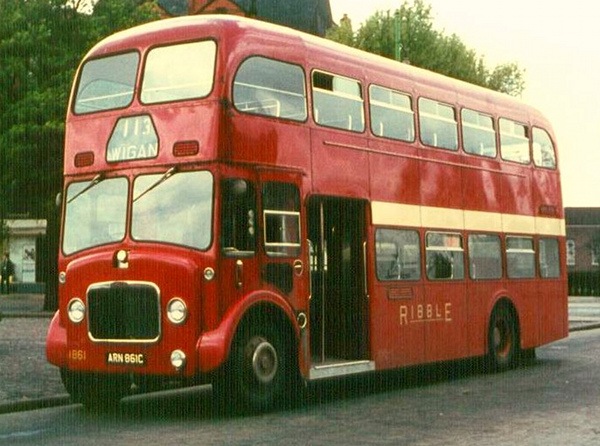
Photograph by ‘unknown’ if you took this photo please go to the copyright page.
Here’s one of these from the other side, it doesn’t look any better.
Ronnie Hoye
27/09/12
The Tynesider

Photograph by ‘unknown’ if you took this photo please go to the copyright page.
This monstrosity christened ‘Tynesider’ started life as NNL 49 a 1958 Orion bodied PD3/4 no 49 in Tyneside’s fleet. It was involved in a serious accident and Northern decided to see if it was possible to convert it into an OPO vehicle, but as you can see here it’s being operated with a conductor. The entrance was rather strange with a single door to get on, and a double exit, but they were side by side. A Routemaster was given similar, but less drastic treatment and became ‘Wearsider’ I don’t know what happened to the later, but as far as I’m aware Tynesider is now somewhere in the Liverpool area.
Ronnie Hoye
26/08/14 – 06:54
I think the colour scheme actually showed the bus in quite a good light Ronnie.
Compared with an earlier image of MCN 30K on a really ‘bad hair’ day.
John Darwent
27/09/12
Crellin Duplex
This monstrosity is the prototype of the "Crellin Duplex" half-decker coach body, fitted to a Guy Arab III chassis and registered DCK 111. Every time I look at this picture it makes me smile. Some ugly ducklings grow up to be swans, but while the production versions of the body were a considerable improvement there was nothing swan-like about them either – they just resembled slightly more streamlined horse transporters. Originally delivered to a Preston operator associated with the businessman who funded George Crellin’s design, it ended up on schools work with Butter of Childs Ercall in Shropshire. Just goes to show that British engineers could be both innovative and idiotic simultaneously.
Neville Mercer
27/09/12 – 11:22
Now I’m not so appalled by this one… the integrated and balanced lines are spoilt by the old fashioned side/head lighting and the dumpy Guy radiator out of a children’s book illustration- and the attempt at a Dan Dare cab must have made the drivers a bit flushed, especially with the engine in there too- but you could grow tomatoes. Can you tell us how it worked inside- was it a sort of mezzanine? Why? It does remind me of those double deck RER trains in Paris which for years have crossed the city from the suburbs (now why don’t we do that- call it "Crossrail"…?)
Joe
28/09/12 – 07:26
The seating on the two levels was in interlocking compartments to bring the height down and maximise the seating – the "foot space" for upper deck passengers being in the panelled areas of the lower deck. This prototype was assembled at Farghers depot near Preston, but production versions (I think around 20 of them in total to at least three different designs) were made at first by the Lincolnshire Trailer Co and then by Mann Egerton. Some of them could seat up to 52 passengers in a 30 ft body. Passengers, however, hated the seating arrangement and very few operators were willing to alienate their customers by turning out a glorified horse-box with weird seating. One of the late production Mann Egerton versions survives in preservation and I wish it well – despite nominating this for the Ugly Bus Ball I would love to ride on the sole survivor!
I’m now starting a sweepstake on how long it will be before we see a forward entrance Bridgemaster on this page. I’m betting on days rather than weeks.
Neville Mercer
28/09/12 – 14:29
…..but Neville, the Southampton and Swindon back loaders, let alone the Tracky and Woolen front loader Roes were even worse. It could end up being a longer post than even the Boddy/East Riding post.
David Oldfield
28/09/12 – 14:31
It may be ugly, but I suppose we have to admire the chap who, in an era of ultra conservatism amongst busmen, was prepared to think completely ‘outside the box’ (to use a modernism) and come up with something so different as this. Nice try.
The separate compartments probably meant that many passengers felt shut in – not very conducive to jolly sing-songs on the way home from the seaside or works outing, and also that half of them would be forced to face backwards – never popular.
I believe a major problem with the heavier underfloor-engined examples was that they were very heavy – especially top heavy – they struggled to pass the tilt test and were frighteningly difficult to stop.
I remember as a young child being taken by my father to look at a Royal Tiger/Mann Egerton halfdecker of Ripponden & District (LWT 146) which was parked on show outside their booking office in Bull Green, Halifax. It is recorded as passing to Cooper of Gilesgate Moor in 1957 and withdrawn in 1961. The one that is currently under restoration is exactly like the Ripponden one and I can’t wait to see it one day.
R&D also had a pair of Foden PVFE6 halfdeckers (KWT 975/6) with two stroke engines, but I do not remember them, though I’m pretty sure I must have heard them !
John Stringer
21/02/16 – 06:41
Re the Crellin Duplex ‘half deckers’ George Crellin not only ripped off and took out a UK patent for a design that had been patented and built in the US in 1928, by brilliant engineer, Dwight E Austin, but he also nicked the name ‘Duplex’, one of its two versions. The other version, a sleeper coach, was called the ‘NiteCoach’. His ‘Duplex’ seated 53, although there was a design for a 72 passenger version.
Both the Duplex and NiteCoach were initially built with high-level normal control engine layout, but the 1932 version of the NiteCoach featured a transverse rear engine with an Austin-patented angle drive. This was the worldwide forerunner of all rear engined buses and is why he and his patent were snapped up by General Motors Corporation, the controlling interest in the bus building and operating arms of the Omnibus Corporation holding company. It also explains why its Yellow Truck and Coach Manufacturing Company, built 300 of the World’s first Austin patent transverse rear engined double deckers, between 1936 and 1938, for the Fifth Avenue Coach Company of New York and Chicago Motor Coach Company, over 20 years before the Atlantean made it into production. For a brief period before joining GM he set up a bus-building company and produced a 20 seat rear engine single decker, the Austin ‘Utility Coach’ which as a point of interest was the World’s first bus with a bustle! As for Crellin, he simply took advantage of the fact that Austin didn’t take out a GB patent.
Malcolm Thwaite
26/09/12
Daimler-Benz Type D38
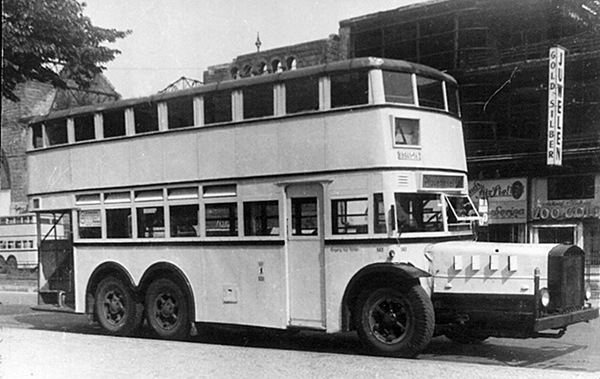
Photograph by ‘unknown’ if you took this photo please go to the copyright page.
You might be interested in this copy/photo, as a follow on from the photo of a not too good looking ex-military Austin K6 with unknown body.
"For a second posting, may I suggest this vehicle as a contender for an other ugly bus. This Berlin 1939 Daimler-Benz Type D38 may be easy on the maintenance, but is not easy on the eye! These vehicles were modified towards the end of World War II to run on town gas, held in tanks of the upper deck, reducing passenger capacity considerably, one would imagine!"
Chris Hebbron
26/09/12 – 17:35
Well, where do you begin? It’s enough to give you nightmares. If that crocodile snout took a crafty sideways bite, it could have your leg off as it pulled in to a stop. It is the one vehicle that could make a Bridgemaster look elegant. Beware – this is what happens when people try to apply the clever Dennis Ace principle to (much) larger vehicles. Maybe they built them like that so that no-one would want them as war reparations. The possible abuse is endless!
Stephen Ford
26/09/12 – 18:20
I’m more bothered about the four machine gun ports on the bonnet side.
David Oldfield
28/09/12 – 07:52
Whilst not in the same league aesthetically as similar period bodies by Charlie Roe, Eastern Coachworks or Weymann, on the positive side you could make a good Lego model of it without too much difficulty…..
Brendan Smith
18/12/14 – 10:31
Here is a blog with another crocodile snout, this time a Mercedes Benz. //tinyurl.com/m2zqzqm
John Lomas
19/12/14 – 05:44
Well, I clicked John Lomas’s link to the Mercedes-Benz blog and was confronted by the snouted monster, but I just didn’t find it ugly. To my eye it looks solid and purposeful, with no silly frills or meaningless curves that don’t join up with other meaningless curves. I’m sure it must have been more robustly built than the Mercedes Citaros that rattle and clatter their way round Oxford with dislodged ceiling panels threatening to fall at any moment, and I bet the old six-wheeler had gentler brakes than those of the Citaro, which seem to bind up and lock just before the crate comes to a halt.
But I’m glad I don’t have to pull the old one round tight corners, full lock and full load—unless Mercedes had already developed power steering for it.
Ian T
28/05/12
‘What On Earth Were They Thinking Of?’
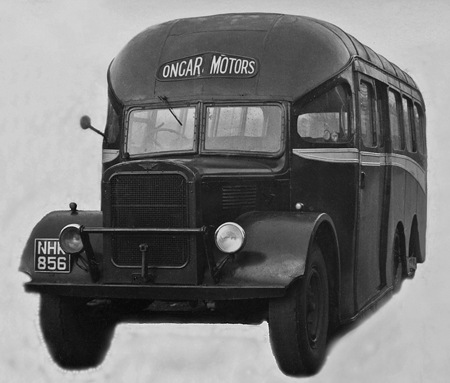
Photograph by ‘unknown’ if you took this photo please go to the copyright page.
Not so much a ‘Do You Know ?’ as a ‘What On Earth Were They Thinking Of?’
A while back somebody asked which had been the ugliest bus.
There have been some monstrosities over the years, but I would like to offer this as my contender for the title.
What we can see clearly is that it was registered NHK 856, and was owned by Ongar Motors.
It appears to have been based on an WW2 ex-WD Austin K6 6×4 lorry chassis.
Other than that:
Who were Ongar Motors ?
Who built the bodywork ?
What, when, where and above all else – Why ?
John Stringer
28/05/12 – 11:01
It’s definitely an Austin K6: I had the job of ferrying three K6’s from Stranraer to Edinburgh in my RAF National Service days, straight after passing my test in a Morris Minor! Lovely petrol engines and sounds not unlike a Bedford O(W)B. What makes the vehicle so unattractive is keeping the original windscreen arrangement, necessitating the swooping front dome. No frontal passenger view worth mentioning.
Chris Hebbron
29/05/12 – 17:23
Not so much an answer, John, as a ‘Thank you’ for an absolutely wonderful picture. As for the questions you posed, you had me in tears. Fabulous! The vehicle is so ugly, it’s almost appealing, isn’t it? My father worked in Malaya in the 1950’s and some of the local bus companies ran vehicles based on ex-US Army 3 ton Dodge and Ford chassis, but none of the local body builders ever came up with anything as striking as this. Do hope someone has a full answer to your question.
Roy Burke
28/09/12 – 07:22
Equally important, John, is which. There should be a witchhunt to find the guilty parties!
Chris Hebbron
07/12/14 – 17:16
Hi John, I’ve belatedly found an answer about this vehicle after buying John Carman’s book "Austin K Series Buses and Coaches" yesterday from MDS Books. NHK 856 was a 1943 Austin K3YY, originally delivered to the RAF as a crew-bus with a separate cab and a "passenger area" (loosely speaking!) on the flatbed. It was one of two converted into PSVs in the summer of 1948 by Wesley of Newport Pagnell – is this the same company as well known independent Wesley of Stoke Goldington I wonder? Both were delivered to the Ongar Motors & Transport Co Ltd (the other one was registered NTW 360 and had a slightly improved version of this monstrous design). My thanks to John Carman for this info and for an excellent read – I’m going offline now to look at it some more.
Neville Mercer
